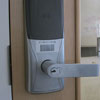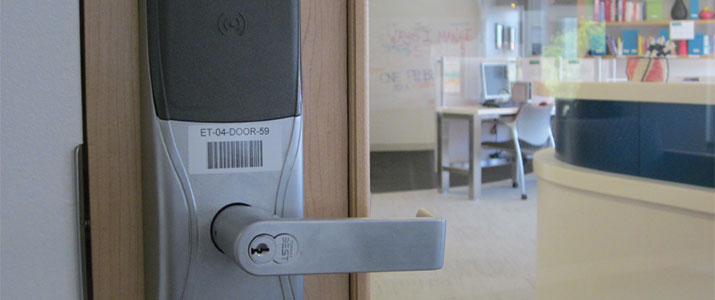
College Upgrades
Wireless locks in place at Queensborough campus
- By Ann Geissler Timme
- Apr 01, 2014
 Reflecting the uniqueness and diversity of the local Queens’ community,
for more than 50 years, Queensborough Community College
has served students from Queens and the entire New York City region
as a starting place to pursue their academic and career goals.
This educational facility serves more than 15,000 students, who
are enrolled in associate degree or certificate programs, as well as another 10,000
students attending continuing education programs. Students typically attend to
either transfer to a four-year college or university or to obtain the skills necessary
for career advancement.
Reflecting the uniqueness and diversity of the local Queens’ community,
for more than 50 years, Queensborough Community College
has served students from Queens and the entire New York City region
as a starting place to pursue their academic and career goals.
This educational facility serves more than 15,000 students, who
are enrolled in associate degree or certificate programs, as well as another 10,000
students attending continuing education programs. Students typically attend to
either transfer to a four-year college or university or to obtain the skills necessary
for career advancement.
Since Queensborough students do not live on campus, this community college
has no housing security issues, leaving the school’s main concerns to include securing
property and expensive equipment along with simplifying the process of access
control. Therefore, to upgrade its building security and simplify access control
management, Queensborough Community College replaced mechanical and offline
locks with online wireless locks that incorporate interchangeable card readers
with the flexibility to accommodate future generations of credentials.
“We were installing a lot of high-tech podiums that have video displays and
electronic white boards,” said James McKee, administrative superintendent. “Because
of their expense, we wanted to protect the equipment against theft and vandalism,
so we started by installing offline, electronic locks.”
Originally, the college used computer-managed, offline locks that worked well
with a relatively small number of interior doors. As security needs increased,
though, uploading and downloading data from each lock with a handheld device
became too time consuming, so a practical solution for upgrading the locks was
needed. In addition, the college was in the process of implementing a Blackboard
Transact system to manage access control and transactions across the campus and needed a solution that would be compatible.
The Lock of Choice
To meet these needs, Queensborough selected Schlage AD-400 locks, providing
online, real-time lock control. Because these locks are wireless, installation was
easier and less expensive than running wires to each door, especially since many of
the campus buildings are 30 to 40 years old.
These locks are designed with easily changeable reader modules so they can
be upgraded in the future without changing the entire lock. They combine all the
hardware components required at the door into one integrated design that incorporates
the electrified lock, credential reader, request-to-exit switch, and door position
switch and tamper guard.
Lock Installation
The college began by installing the locks in three major facilities: the science building,
the humanities building and, most recently, the medical arts building. All three
included areas where there was expensive, high-tech equipment that could be subject
to theft or vandalism.
“They were just regular classrooms to begin with, so they didn’t even have highsecurity
locks with restricted keys,” McKee said.
McKee estimates that approximately 125 AD-400 locks now are installed in
the three buildings. Each floor typically has two Panel Interface Module (PIM)
units hard-wired to the panels that transmit data from the wireless locks to the
Blackboard system.
Many of the doors now equipped with the electronic locks originally had a unit
lock that required a cutout in the door. Removing these locks made it necessary to
install a special filler plate to cover the cutout before installing the AD-Series lock.
McKee said that using the filler plates saved the expense of replacing the doors.
Even More Security
A new perimeter door security program is now underway to upgrade campus-wide cameras and access control. In most
cases, these doors will be equipped with
the AD-Series locks and Von Duprin
993 Exit Trim. Both the cameras and
access control products will be hardwired
for these applications.
Other than a few proximity cards
used by building and grounds staff for
parking access, magnetic stripe cards are
used for all credentials. These are compatible
with both the electronic locks
and the Blackboard system. In addition
to building access, McKee said that
these cards are used for other types of
transactions such as student parking.
“Instead of buying tokens, they just
swipe their card, which gives them access
and charges a parking fee to their
account,” MeKee said.
The card system also makes it easier
to control access and less expensive to
make changes than with the mechanical
keys that were used previously in
many of the buildings. While turnover
is relatively low for full-time professors,
there is a higher rate of change for adjunct
professors and other staff members.
In these cases, as well as for lost
cards, a change to the database can be
made and new cards issued quickly.
As an active research facility, the
Queensborough faculty includes 62
percent with doctorates, many of
whom are engaged in research and
publication in their academic fields.
Frequently, ongoing experiments in
various laboratories must be secured
to prevent them from being disturbed.
In most cases, the college uses highsecurity
mechanical keys and regulates
their distribution tightly to control
these areas. McKee said that key
control is generally not a problem for
these functions.
This article originally appeared in the April 2014 issue of Security Today.